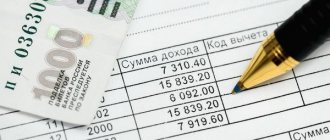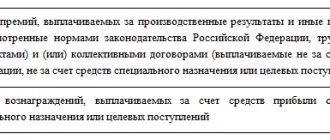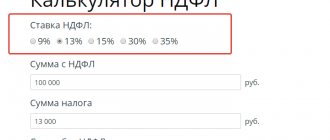Tax deduction codes: table description
Let's look at the commonly used tax deduction codes when filling out a 2-NDFL certificate:
- 126 - code that is indicated when providing a standard deduction for a child under 18 years of age or a full-time student under 24 years of age in the amount of 1,400 rubles.
- 127 - standard deduction in the same amount provided for the 2nd child.
- 311 - property deduction for the purchase of housing, if the employee has expressed a desire to receive this deduction through the employer.
- 320 - social deduction for employee expenses on their own training.
- 321 - social tax for children's education.
ATTENTION! If an employee has brought several notifications, for example, about the right to property and social deductions, a separate page of the 2-NDFL certificate is filled out for each of them. On the second and subsequent pages, only the fields “TIN”, “KPP”, “Page”, “Certificate number”, “Reporting year”, “Characteristic”, “Adjustment number”, “Submitted to the tax authority (code)” are filled in. “Notification type code”, “Notification number”, “Date of issue of the notification” and “Code of the tax authority that issued the notification”.
Deductions for children: their size
To begin with, we note that every family with children has the right to receive a tax deduction. At the same time, it is not fundamentally important how this child came into the family. Natural parents, adoptive parents, guardians, etc. are entitled to the deduction. Parents have the right if:
- The family has a minor child under 18 years of age;
- The child is a student, graduate student, resident, etc. Here the right is not lost until the child is 24 years old, but provided that the form of education is full-time and not part-time.
The right to a tax deduction is automatically liquidated if one of the following events occurs:
- The child becomes an adult and does not continue his full-time studies at a university;
- The child officially becomes a spouse, that is, marries another person;
- Death of a child.
Depending on how many children there are in the family, what their age is, whether there are disabled children, etc. There are different amounts of deductions. This must be taken into account.
Deduction sizes:
- in the amount of 1,400 rubles for parents who have a child or are his guardian. In this case, such a deduction will be applied until the total amount of income from the beginning of the year for such a parent reaches 350 thousand rubles;
- in the amount of 3000 rubles. for parents and guardians of families in which a second or third child is born. The accrual algorithm is similar to the previous version;
- in the amount of 12,000 rubles. if the family has a disabled child. In this case, the child’s disability group is not an important fact. But only if the parents are related. If the child is raised by guardians, then the tax benefit will be only 6,000 rubles;
In addition to size, many are concerned about the second parent's right to receive a tax deduction. By law, each parent has the right to apply such a deduction, but only if the income received is subject to personal income tax.
What are tax deduction codes for?
The tax deduction code is a digital code. A deduction is an amount that, if there are documented grounds, can be reasonably deducted from the tax base, thereby reducing not only it, but also the amount of tax accrued from this base.
The deduction code is required when filling out the tabular part of the 2-NDFL certificate, which serves:
- a tax agent reporting form on the payment of income and the amount of tax withheld from it;
- tax agent reporting form on unwithheld tax on income paid;
- a document confirming the amount and types of income received by the taxpayer at the place of work, and the amount of personal income tax paid by him when applying to various authorities (for example, for a new job, to the Federal Tax Service, bank).
Find out whether the deduction code should be indicated in the application for its receipt from the sample compiled by ConsultantPlus experts, having received trial access to the system.
Documents for deduction. Code 127
Tax deduction codes 126 and 127 are similar, therefore they have a similar set of documents. However, for the latter it will be somewhat wider.
If an employee has two children under eighteen years of age or full-time students, he must provide the following documents:
- Personal statement. You can fit both children into one at once.
- Birth certificates of both children, as well as copies of them. It is worth noting that even if the child already has a passport, it is the certificate that is provided, since this document contains information about the parents.
- Certificate in form 2-NDFL, if the employee gets a job.
It is also worth noting that if the first child no longer fits the category of persons for whom the deduction is provided, then a certificate for him still needs to be brought. This confirms the fact that the child for whom code 127 is used is the second.
Which deduction table is used in 2020-2021?
The last time changes were made to the deduction table was from 01/01/2018. A new deduction code 619 was added to it, which is intended to display a positive financial result for transactions that are recorded on an individual investment account (Order of the Federal Tax Service of Russia dated October 24, 2017 No. ММВ-7-11 / [email protected] ). But the main changes in the table of deduction codes occurred from December 26, 2016 (order of the Federal Tax Service of Russia dated November 22, 2016 No. ММВ-7-11 / [email protected] ). The most noticeable thing for most tax agents then was the change in deduction codes for children.
Tax officials plan to introduce new deduction codes for personal income tax. The draft corresponding order as of January 25, 2021 has already undergone public discussion and is being prepared for publication. Read more about the new codes here.
Standard tax deduction for children: who can receive it, its size in 2020, how to apply
If there are three children in a family, then the first two are entitled to a deduction of 1,400 rubles, and the third - 3,000, in total the tax base can be reduced by 5,800. We get (36,000 – 5800)*13% = 3926. Without deductions, the tax would be 4,680 rubles. The savings per month is 754 rubles, and for the year 6,786 rubles.
Who can provide a deduction for children?
If there is a disabled child in the family, then the amount of the deduction will be larger - 12,000 rubles if he is a natural child and not an adopted child, plus 1,400 standard deduction. In this case, we will receive (36,000 – 12,000-1,400)*13% = 2,938 rubles of income tax. Without applying the deduction it would be 4,680 rubles. The savings per month are already 1,742 rubles, and over the year it will be 15,678 rubles.
Tax deduction 114 in 2021 is also allowed to be issued through the tax authority. To do this, you need to collect the documents listed above. It will need to be supplemented with information about income. In the application, indicate your data, request (in accordance with Article 218), data about children, the amount of compensation due (the tax deduction code is not indicated: 114, 115) and the total amount to be transferred. Also indicate the issuance option - account number or details of the company through which the transfer is made.
- heroes of the USSR; heroes of Russia; WWII participants, incl. civilians or those who took part in the defense of cities without being part of the Soviet Army; those who were in Leningrad during the siege; WWII heroes, combatants; prisoners, concentration camp prisoners, incl. being children; disabled people; persons exposed to radiation sickness when providing assistance in nuclear accidents; persons evacuated from Chernobyl who were exposed to radiation; participants in combat operations in Afghanistan.
Registration in 2021
Tax deduction 114 depends on the level of wages, therefore, when applying for a job, it is worth obtaining a 2-NDFL certificate. If double compensation is issued, additional information about the second parent will be required:
Since January 1, 2017, codes from 114 to 125 have lost their relevance. They were replaced by codes 126 – 149
. The content of the circumstances they designate more fully reflects the set of possible situations in the family.
Note 1.
See below for the latest new codes. All of them are tied to certain family situations. The changes themselves were intended to specify certain aspects of the provision of deductions for children.
New codes
The benefit allows you to reduce an individual’s losses when calculating personal income tax by a certain amount. The interval is 1 400 – 12 000
rub. You can read more about this here (4th subparagraph 1 of Article 218 of the Tax Code of the Russian Federation - “Standard tax deductions”). This article reflects current realities regarding the benefits that citizens, including parents, can receive for their child.
From January 1, 2021, employers will fill out the 2-NDFL certificate using a new form. By order of the Federal Tax Service dated October 2, 2020 No. ММВ-7-11/ [email protected], two new forms were approved at once: for transmission to the Federal Tax Service and for issuance to the employee. Now the certificate for the tax office consists of two sheets, and new details have appeared in it.
This is interesting: Mortgage conditions in Sberbank
What has been changed in the list of deduction codes since 2018?
The adjusted table of deduction codes has retained the main set of codes used in the old table, but at the same time a number of codes have been excluded from it, new ones have been added, old codes have been replaced with new ones, and deduction description texts have been adjusted.
Broken down by type of deduction, the changes look like this:
- Standard codes - excludes codes 114-125. Codes 126–149 have been introduced instead. Now they differ depending on who the deduction is provided to: natural parents (adoptive parents) or persons who replace them.
- Reducing the base according to Art. 214.1 of the Tax Code of the Russian Federation (transactions with securities and financial instruments of forward transactions) - in codes 205–207, instead of expenses on operations with financial instruments of forward transactions, expenses on operations with derivative financial instruments are now indicated, and codes 209–210 reflect no loss on operations with financial instruments of futures transactions, and losses on transactions with derivative financial instruments. Additionally, code 208 was introduced, which reflects losses on transactions with derivative financial instruments.
- Reducing the tax base for securities lending transactions in accordance with Art. 214.4 - instead of code 221, which was used to reflect the amount of expenses on transactions with securities accounted for in an individual investment account, codes 225–252 were introduced. Codes 250–252 have been added, reducing the tax base for transactions accounted for on an individual investment account in accordance with Art. 214.9 Tax Code of the Russian Federation.
- From investment tax deductions provided for in Art. 219.1 of the Tax Code of the Russian Federation, code 617 is excluded.
Structure of the new table of deduction codes
Thus, the new table of deduction codes consists of 14 sections named by types of deductions, and 1 additional code 620, which includes other types of deductions not listed in the table.
The sequence of sections and numbering of codes in them is as follows:
- standard deductions under Art. 218 Tax Code of the Russian Federation - codes 104, 105,126–149;
- reducing the base according to Art. 214.1 Tax Code of the Russian Federation - codes 201–203, 205–210;
- reducing the base according to Art. 214.3 Tax Code of the Russian Federation - codes 211, 213;
- reducing the base according to Art. 214.4 Tax Code of the Russian Federation - codes 215–220; 222–241;
- reducing the base according to Art. 214.9 Tax Code of the Russian Federation - codes 250–252;
- property deductions under Art. 220 Tax Code of the Russian Federation - codes 311, 312;
- social according to clause 2 p. 1 art. 219 Tax Code of the Russian Federation - codes 320, 321;
- social according to clause 3 p. 1 art. 219 Tax Code of the Russian Federation - codes 324–326;
- social according to clause 4 paragraphs 1 art. 219 Tax Code of the Russian Federation - code 327;
- social according to clause 5 p. 1 art. 219 Tax Code of the Russian Federation - codes 328;
- professional deductions under Art. 221 Tax Code of the Russian Federation - codes 403–405;
- deductions for non-taxable income under Art. 217 Tax Code of the Russian Federation - codes 501–510;
- reducing the base according to Art. 214 Tax Code of the Russian Federation - code 601;
- investment deductions under Art. 219.1 Tax Code of the Russian Federation - code 618;
- other deductions - code 620.
The table ends with 5 notes referring to the document details on the basis of which social deductions and deductions with codes 509 and 510 should be applied for non-taxable income.
How to get a child tax credit in 2021
For the first and second born child, the deduction is provided in the amount of 1,400 rubles per month, and for the third, fourth, and so on, the amount increases to 3,000 rubles per month. Deductions for children are provided from the month of birth of the child until the end of the year in which the right to deduction ends. And this right can end for several reasons:
Legal Basis of Standard Deductions
- there are no deductions for Christina (the first child), since she has already reached the age of majority;
- for Valentina (second child) – 1,400 * 12 = 16,800 rubles;
- for Sophia (third child) - 3,000 *12 = 36,000 rubles;
- for Ivan (fourth child) - 3,000 * 12 = 36,000 rubles;
- for Varvara (fifth child) - 3,000 * 5 = 15,000 rubles.
First of all, please note that reducing the tax base for personal income tax for any types of deductions is only the right of the taxpayer. This means that if your employee did not write an application for a child deduction or bring supporting documents, then even if the employer knows about the presence of a child, there is no need to provide a deduction.
This is interesting: Making a Kosgu 2020 banner
What must an employee provide to the employer so that the employer, as a tax agent, can reduce the amount of personal income tax? In sub. 4 paragraphs 1 art. 218 of the Tax Code of the Russian Federation states that in order to receive a deduction, it is necessary to provide an application and documents confirming the right to deduction. However, the Tax Code does not describe the exact package of documents.
In which field is it indicated?
The amount of tax deduction for the natural or adopted first child is given in subparagraph. 4 paragraphs 1 art. 218 Tax Code of the Russian Federation. It is 1,400 rubles each month. There is a limit on the amount of income, which we will discuss below.
The child tax credit code in 2021 depends not only on the child's account and whether the child is disabled, but also on who is receiving the credit (for example, a parent or guardian). Let's say, the deduction code for the first child, when the deduction is provided to the parent, is 126, and the deduction codes for two children 2020-2020 for guardians are 130 (first child) and 131 (second child). The deduction code for the second disabled child is the same as for the first, but depends on who is receiving the deduction. For example, the deduction code for a disabled child in 2020-2020 is indicated as 129 when providing a deduction to a parent or adoptive parent, and 133 to a guardian or adoptive parent.
Information about child deductions provided to the employee must be indicated by the employer, acting as a tax agent, in the 2-NDFL certificates. At the same time, the certificates reflect not only the amount of such deductions, but also the corresponding code (Order of the Federal Tax Service dated October 30, 2015 No. ММВ-7-11 / [email protected] ). We will tell you what deduction codes for children need to be included in 2-NDFL certificates in our consultation.
Child deduction 2021: deduction code
When calculating personal income tax on income taxed at a rate of 13%, individuals may be provided, among other things, with standard tax deductions. Among them, deductions for children are the most common (Clause 1, Article 218 of the Tax Code of the Russian Federation). We talked about the amount of children's deductions, the basis and deadline for their provision in our consultation.
Every year, tax agents send to the Federal Tax Service information about income paid to the employee and personal income tax withheld. There is a special form for this - certificate 2-NDFL. In it, the employer must indicate what deductions were provided to the employee. The information is transmitted to the Federal Tax Service in encoded form, each type of deduction has its own code.
In 2-NDFL, the employer reflects all income that it paid to individuals during the year. Usually these are salaries and payments under civil contracts. In addition to income, in the certificate the tax agent indicates the standard tax deductions that he provided to the employee. Most often, employers have to indicate deduction codes for children.
What deduction code for a child should I indicate in the new 2-NDFL certificate in 2020?
From January 1, 2021, employers will fill out the 2-NDFL certificate using a new form. By order of the Federal Tax Service dated October 2, 2020 No. ММВ-7-11/ [email protected], two new forms were approved at once: for transmission to the Federal Tax Service and for issuance to the employee. Now the certificate for the tax office consists of two sheets, and new details have appeared in it.
This benefit should be established for every employee who has children under the age of 18. If they are studying at a higher institution and have the status of cadets, graduate students, students, residents, then the period for obtaining benefits for them is extended to 24 years.
This is interesting: Remuneration for adoptive parents in Bashkiria 2020
Standard deduction codes 104, 105, 126–149 in the 2-NDFL certificate
These deduction codes, which give the employee the right to a personal deduction either due to special merits or because he has children, are most often included in the 2-NDFL certificate. In the new table, those that have been used since 2012 are kept unchanged. They are divided into the following groups:
- codes 104 and 105 - personal deductions in the amount of 500 rubles. and 3,000 rubles, provided to a person who has special services to the country (combatants, liquidators of accidents at nuclear facilities, holders of state awards);
- deduction codes 126, 127, 128 - presented to parents, spouse of a parent, adoptive parent for the 1st, 2nd, 3rd (and subsequent) children under the age of 18 years or up to 24 years old if the child is studying;
- code 129 - for a deduction provided to the parent, spouse of the parent, adoptive parent, who is supporting a child under the age of 18 years or up to 24 years old, if the child is a disabled person of group I or II;
- codes 130, 131, 132 - deductions for a child under 18 years of age or up to 24 years of age if the child is studying; deductions are submitted to the guardian, trustee, adoptive parent, spouse of the adoptive parent;
- code 133 - for a deduction for a guardian, trustee, foster parent, spouse of a foster parent who is supporting a child under the age of 18 or under 24 years if the child is a disabled person of group I or II;
- codes 134, 136, 138 - double deduction presented to the only parent, adoptive parent for the 1st, 2nd, 3rd (and each subsequent) child under the age of 18 years or up to 24 years old if the child is studying;
- codes 135, 137, 139 - double deduction presented to the sole guardian, trustee, foster parent, adoptive parent for the 1st, 2nd, 3rd child under the age of 18 years or up to 24 years old if the child is studying;
- code 140 - for a double deduction provided to the only parent, the adoptive parent, who is supporting a child under the age of 18 or up to 24 years, if the child is a disabled person of group I or II;
- code 141 - double deduction provided to the sole guardian, trustee, foster parent who is supporting a child under the age of 18 or up to 24 years if the child is a disabled person of group I or II;
- codes 142, 144, 146 - double deductions for the 1st, 2nd, 3rd (and subsequent) children under the age of 18 years or 24 years old if the child is studying; such deductions are presented to one of the parents of their choice on the basis of an application for the refusal of the second parent to receive a tax deduction;
- codes 143, 145, 147 - double deductions for the 1st, 2nd, 3rd (and subsequent) children under the age of 18 years or 24 years old if the child is studying; deductions are presented to one of the adoptive parents of their choice on the basis of a statement of refusal of the second adoptive parent to receive a tax deduction;
- code 148 - double deduction for a disabled child under the age of 18 or a student under the age of 24 who is a group I or II disabled person, which is presented to one of the parents of their choice on the basis of an application for the second parent’s refusal to receive a tax deduction;
- code 149 - double deduction for a disabled child under the age of 18 or a student under the age of 24 who is a group I or II disabled person, who is presented to one of the adoptive parents of their choice on the basis of an application for the refusal of the second adoptive parent to receive a tax deduction .
Read about all the deductions to which a taxpayer with children is entitled in the article “Tax deductions for children in 2021 (personal income tax, etc.)” .
If you find it difficult to provide a deduction to an employee in a particular situation, use free access to ConsultantPlus and go to the Ready Solution.
general information
A tax deduction is a kind of benefit for an employee.
It is noteworthy that there are several types. The most popular are personal deductions for children. The first includes small amounts that are not taxed and to which war veterans, as well as disabled people of the first and second groups, are entitled.
The second broad group includes those amounts that are not taxed at a rate of thirteen percent due to the fact that the employee has children. Here the classification is quite large-scale, since the deduction code is affected by everything, from the presence of a second parent to what kind of child the child is.
There are more codes, since one deduction received two codes depending on who it is provided to. Until December 26, 2016, there was no such division.
- For example
, in the adjusted list, the deduction for the first child has two codes: - code 126 is assigned to the deduction for a child provided to the parent, his husband or wife, or the adoptive parent; - - code 130 indicates the same deduction, but already provided to the guardian, trustee, adoptive parent, his spouse.
The separation of codes was required because from 2021, the size of the deduction for a disabled child began to differ depending on who it is provided to. If the parent, his husband or wife, or adoptive parent, then 12 thousand rubles. If the adoptive parent, his spouse, guardian, trustee, then 6 thousand rubles.
In the same way, the amount of deduction for a full-time student, graduate student, resident, intern, student under the age of 24 years old, if he is disabled in group I or II, changes in the same way.
Property deduction codes
There are 2 main types of property deductions related to the purchase of housing, which, with permission obtained from the Federal Tax Service, can be fully used at work:
- code 311 - deduction for direct expenses on the purchase or construction of housing;
- code 312 - deduction for interest paid for a mortgage related to the acquisition of housing, which also takes into account interest paid when refinancing mortgage loans.
To learn how to get a deduction for an apartment purchased with a mortgage, read the material “Tax deduction when purchasing an apartment with a mortgage (nuances)” .
Standard child tax deduction: filling out sheet E1
In this article we will analyze a sample of filling out the 3-NDFL declaration (Sheet E) in the “Declaration” Program.
We recommend reading: Living wage in Moscow for children
It is filled out if you have children, that is, you need to apply for a standard child tax deduction. In this video we will talk in detail about how to add information about the presence of children to the 3-NDFL Declaration.
In previous articles, we looked at the most convenient way to fill out 3-NDFL Declaration forms in a specialized program, where to get it, and also how to fill out the first tabs. Namely: setting the conditions, information about the declarant and income received in the Russian Federation. Therefore, if you have questions about how all this data is filled out, where to get what information, you can find the answers by following the links.
Well, we move on to child deductions and look at two situations when it is necessary to use the standard child tax deduction. Contents of the article
- 2 Children's deductions at work
- 2.1 Recording income
- 2.2 Deductions tab
- 3.3 Changing the number of children
- 3.2 Adding children's Deductions
- 4 Combination of standard and other deductions
- 3 The employer does not provide deductions for children
- 3.1 Fill out the Income section
- 3.2 Adding children's Deductions
- 3.3 Changing the number of children
- 3.4 From what point does the child deduction apply?
- 2.2 Deductions tab
- 5 Help in filling out
- 1 When is it important to remember children?
- 3.1 Fill out the Income section
- 3.4 From what point does the child deduction apply?
- 2.1 Recording income
Social deduction codes
From 2021, in a manner similar to the provision of property deductions (with a permit issued by the Federal Tax Service after checking documents confirming the right to deduction), it is possible to receive social deductions at the place of work. Their codes have not changed:
- code 320 - deduction for expenses for own education or full-time education of a sister (brother) under the age of 24;
- code 321 - deduction for expenses for full-time education of children (including foster children or wards) under the age of 24 years;
- code 324 - deduction for medical expenses for yourself, your spouse, parents or children (including adopted or warded children) under the age of 18;
- code 325 - deduction for contributions paid for voluntary health insurance for oneself, spouse, parents or children (including adopted or warded) under the age of 18;
- code 326 - deduction for expenses for expensive treatment;
- code 327 - deduction for expenses on paying contributions to non-state pension funds or under long-term voluntary life insurance contracts for yourself, your family members, close relatives;
- code 328 - deduction for additionally paid by the taxpayer savings contributions to the Pension Fund.
See also “Documents for obtaining a tax deduction for treatment” and “Application for a personal income tax refund for education - sample and form.”
Code 126 deduction: what is it?
Tax deduction with code 126 indicates a personal income tax benefit for the first child. It is noteworthy that it can be used not only by those whose child is under eighteen years of age. If a certificate from an educational institution is provided confirming that the child is a full-time student, the benefit continues to apply until the child reaches twenty-four years of age.
It is also worth noting that this deduction code has been used since the end of 2016. Previously, it corresponded to code 114, which also applied to the first child who had not reached the age of majority or was receiving education, but only in full-time education.
The amount of deduction code 126 is 1400 rubles. This means that this particular part of the employee's salary is not subject to tax. That is, a monthly savings of 182 rubles.
We also must not forget that the deduction ceases to apply if the amount of wages for a calendar year reaches 350,000 rubles. In the month in which this amount was collected, deduction codes 126 and 127 will not be valid.
Deduction codes for non-taxable income
Deductions for non-taxable income have not changed. However, they also appear in the 2-NDFL certificate quite often, so it makes sense to recall their list:
- codes 501 and 502 - deductions for the value of gifts given at work and prizes received at competitions;
- codes 503 and 504 - deductions for payment of financial assistance to employees and reimbursement of the cost of medicines;
- code 505 - deduction for prizes received as a result of participation in promotional events;
- code 506 - deduction for financial assistance paid to a disabled person by a public organization of disabled people;
- code 507 - deduction for financial assistance or gift given to a WWII participant;
- code 508 - deduction for financial assistance at the birth (adoption) of a child.
- code 509 - deduction for income issued by products to an employee of an agricultural producer;
- code 510 - deduction for additional savings contributions to the Pension Fund of the Russian Federation paid by the employer for the taxpayer.
Investment deduction codes
The bulk of these deductions are associated with operations that have a fairly limited distribution. Their codes are used by professional participants in the securities market to compile 2-NDFL certificates. Most regular employers do not require these codes.
Among this group, only deduction code 601 for dividend income may be of interest to an ordinary employer. From January 2021, as noted above, a new investment deduction with code 619 was introduced.
As of January 1, 2018, taxpayer income codes indicated in the 2-NDFL certificate have also been updated. See details here .
Results
Deductions allow you to reduce the tax base for personal income tax. All deductions are encrypted with special codes, which are recorded in the 2-NDFL certificate. At the end of 2021, the list of codes was significantly expanded, and in December 2017, a new code 619 for investment deduction was added.
Sources:
- Order of the Federal Tax Service of Russia dated October 24, 2017 N ММВ-7-11/ [email protected]
- Order of the Federal Tax Service of Russia dated November 22, 2016 N ММВ-7-11/ [email protected]
- Tax Code of the Russian Federation
You can find more complete information on the topic in ConsultantPlus. Free trial access to the system for 2 days.








